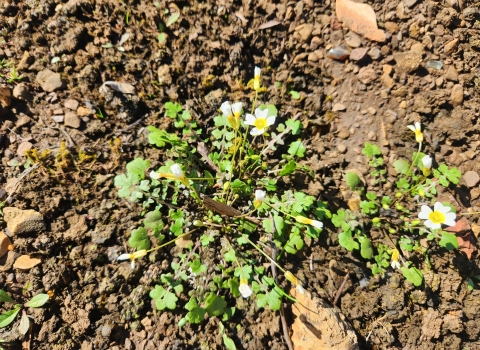DENVER — Since 1908, when the National Bison Range in western Montana was established by conservation visionary President Theodore Roosevelt, this cherished 18,800-acre national wildlife refuge national wildlife refuge
A national wildlife refuge is typically a contiguous area of land and water managed by the U.S. Fish and Wildlife Service for the conservation and, where appropriate, restoration of fish, wildlife and plant resources and their habitats for the benefit of present and future generations of Americans.
Learn more about national wildlife refuge has continued to play a vital role in the conservation and recovery of American bison. Several hundred bison now thrive on these accessible public lands, which also support Rocky Mountain elk, mule deer, white-tailed deer, pronghorn, bighorn sheep, and over 200 bird species.
As part of its ongoing efforts to plan for the future of the National Bison Range and continue the refuge's conservation legacy, the U.S. Fish and Wildlife Service today announces a 45-day public comment period and three public meetings for a draft Comprehensive Conservation Plan (CCP) and associated Environmental Impact Statement (EIS).
The draft CCP/EIS is available for review on the National Bison Range Complex CCP Planning website. A notice will publish in the Federal Register opening a 45-day public comment period.
Members of the public are invited to submit comments from April 5, 2019 through May 20, 2019. Public comments concerning the draft CCP/EIS can be submitted via email to scoping_NBR@fws.gov or by postal mail to: Bernardo Garza, U.S. Fish and Wildlife Service, Branch of Planning and Policy, 134 Union Boulevard, Suite 300, Lakewood, Colorado 80228.
Following the public comment period, the Service will analyze comments received, publish a final CCP/EIS, and make a final determination about the preferred management alternative for implementing the CCP.
Once finalized, the CCP will determine resource management and visitor recreational goals, including public use and access, for the National Bison Range over the next 15 years.
A planning team of federal, Tribal, state, and local government agencies jointly developed the draft CCP/EIS. These cooperating agencies include: the Confederated Salish and Kootenai Tribes; Bureau of Indian Affairs; Montana Fish, Wildlife and Parks; Lake County; and Sanders County.
The planning team initially developed five alternatives for the refuge. After reviewing input from an initial public comment period in May 2018, the planning team revised these proposed alternatives.
The current draft CCP/EIS includes three management alternatives. The first alternative, known as the No Action Alternative (Alternative A), would continue all current management activities and maintain funding, infrastructure, all programs, and staffing with few changes.
The other two alternatives are as follows:
Alternative B
This alternative emphasizes managing habitat and wildlife populations to provide quality, wildlife-dependent opportunities for the public. The Service would maximize the quality of recreational opportunities by providing improved access, facilities, interpretive materials, and environmental education. The Service would also aim to enhance the quality of the public’s experience by maintaining healthy wildlife populations and habitats that support activities such as wildlife observation, photography, interpretation, education, and fishing. Working with partners, through existing and new partnerships, is also a key component of this alternative.
Alternative C - Proposed Action
This alternative emphasizes maintaining and/or enhancing ecological communities, recognizing ever-changing environmental conditions. In cooperation with our partners, the Service would use a prioritization framework to identify and define future conditions that would drive management actions to:
- Build ecological community resiliency
- Promote species diversity and genetic diversity
- Build sustainability in management capacity and operations
This alternative seeks to facilitate collaborative, cooperative, and coordinated management of the National Bison Range with our federal, Tribal, state, local, public, and private partners. It seeks to provide better opportunities for fish, plant, and wildlife habitat on lands outside the boundaries of the refuge by creating corridors conducive to wildlife migration and movement. It also seeks to incorporate the expertise, resources, and efforts of our partners to help facilitate the benefits of a broader functioning landscape.
Some management elements are common to all three alternatives, such as: management of surplus bison; prescribed fire management; collaboration with partner agencies; protection of natural and cultural resources; collaboration with the Confederated Salish and Kootenai Tribes in utilizing traditional ecological knowledge; and, developing educational and interpretative materials including exhibits and programs.
The Service will hold three public meetings on the draft CCP/EIS. These meetings will follow an open-house format. Brief presentations will be provided at 6:00 p.m. and attendees are invited to arrive any time between 5:00 p.m. and 8:00 p.m. to meet with Service personnel, learn more about the CCP/EIS process, and provide input.
Information about each meeting is detailed below:
Date: April 30, 2019 Time: 5:00 p.m. - 8:00 p.m.
Location: Missoula Public Library
Address: 301 E Main St, Missoula, MT 59802
Venue Phone: 406-721-2665
Date: May 1, 2019
Time: 5:00 p.m. - 8:00 p.m.
Location: Red Lion Inn
Address: 209 Ridgewater Dr, Polson, MT 59860
Venue Phone: 406-872-2200
Date: May 2, 2019
Time: 5:00 p.m. - 8:00 p.m.
Location: National Bison Range Visitor Center
Address: 58355 Bison Range Rd, Charlo, MT 59824
Venue Phone: 406-644-2211
The National Bison Range lies entirely within the boundary of the Flathead Indian Reservation of the Confederated Salish and Kootenai Tribes. It is one of six units in the National Bison Range Complex, which also includes Lost Trail, Ninepipe, and Pablo National Wildlife Refuges, and two wetland management districts. A separate environmental assessment (EA) will be developed for these remaining five units of the refuge complex (along with a CCP) in the future.
The mission of the U.S. Fish and Wildlife Service is working with others to conserve, protect, and enhance fish, wildlife, plants, and their habitats for the continuing benefit of the American people. For more information on our work and the people who make it happen in the West, connect with us on Instagram and Facebook, follow us on Twitter, watch our YouTube channel at and download public domain photos from Flickr.


